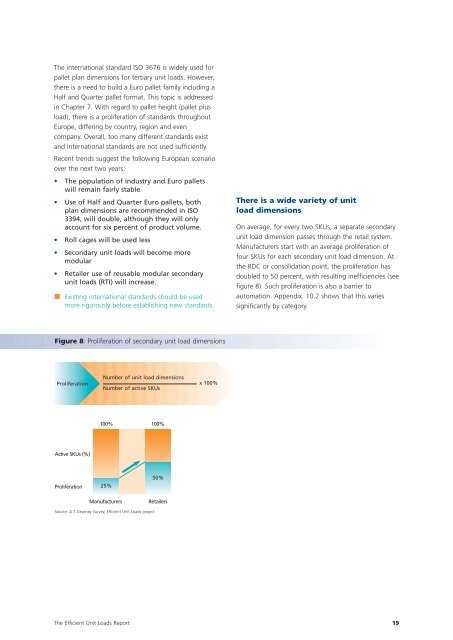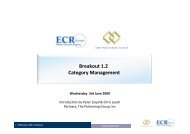Create successful ePaper yourself
Turn your PDF publications into a flip-book with our unique Google optimized e-Paper software.
The international standard ISO 3676 is widely used for<br />
pallet plan dimensions for tertiary unit loads. However,<br />
there is a need to build a Euro pallet family including a<br />
Half and Quarter pallet format. This topic is addressed<br />
in Chapter 7. With regard to pallet height (pallet plus<br />
load), there is a proliferation of standards throughout<br />
Europe, differing by country, region and even<br />
company. Overall, too many different standards exist<br />
and international standards are not used sufficiently.<br />
Recent trends suggest the following European scenario<br />
over the next two years:<br />
• The population of Industry and Euro pallets<br />
will remain fairly stable<br />
• Use of Half and Quarter Euro pallets, both<br />
plan dimensions are recommended in ISO<br />
3394, will double, although they will only<br />
account for six percent of product volume.<br />
• Roll cages will be used less<br />
• Secondary unit loads will become more<br />
modular<br />
• Retailer use of reusable modular secondary<br />
unit loads (RTI) will increase.<br />
Existing international standards should be used<br />
more rigorously before establishing new standards.<br />
Figure 8: Proliferation of secondary unit load dimensions<br />
Proliferation<br />
Active SKUs (%)<br />
Proliferation<br />
Number of unit load dimensions<br />
Number of active SKUs<br />
100% 100%<br />
25%<br />
Source: A.T. Kearney Survey, Efficient Unit Loads project<br />
50%<br />
Manufacturers Retailers<br />
x 100%<br />
There is a wide variety of unit<br />
load dimensions<br />
On average, for every two SKUs, a separate secondary<br />
unit load dimension passes through the retail system.<br />
Manufacturers start with an average proliferation of<br />
four SKUs for each secondary unit load dimension. At<br />
the RDC or consolidation point, the proliferation has<br />
doubled to 50 percent, with resulting inefficiencies (see<br />
figure 8). Such proliferation is also a barrier to<br />
automation. Appendix. 10.2 shows that this varies<br />
significantly by category.<br />
The Efficient Unit Loads Report 19










